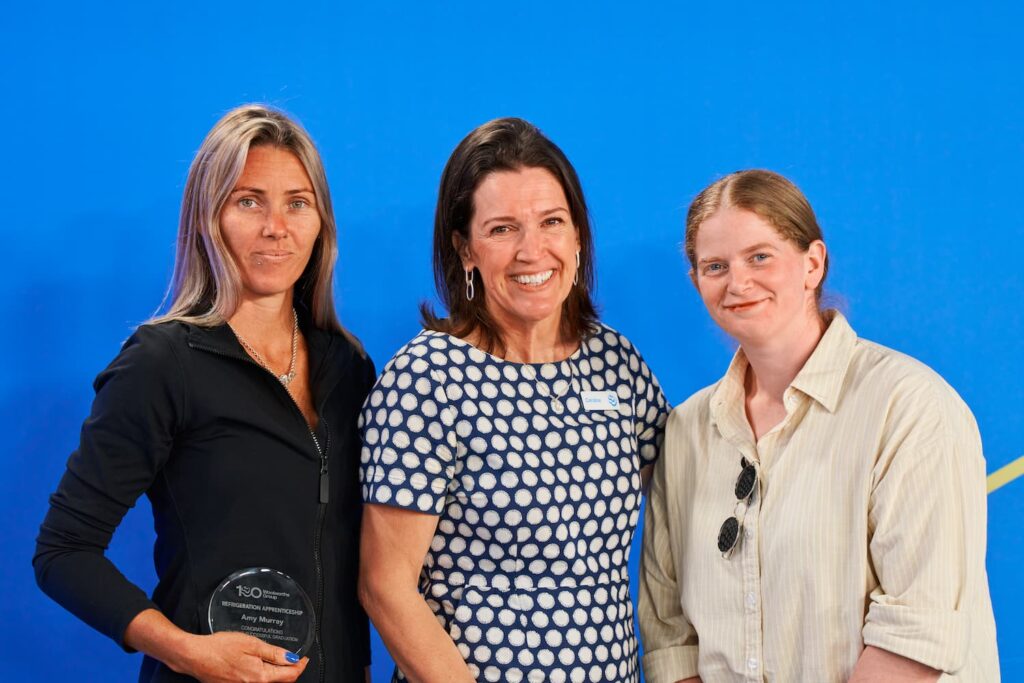With the Australian HVAC&R sector facing a trade skills shortage, Nick Johns-Wickberg looks at novel approaches to recruiting and retention.
What comes to mind when you think of a trade apprentice?
We’re willing to bet that the apprentice in your mind’s eye has two defining features: they’re young and male.
The statistics support the stereotype; according to a report by the National Centre for Vocational Education Research (NCVER), 88 per cent of apprentices across all trades in 2021 were male, with 55.3 per cent having left high school before completing year 12.
For school-leavers, starting a highly skilled, well-paid profession with a clear pathway for career development is extremely attractive. The benefits flow both ways; recruiting young people who are passionate about practical, hands-on work is a boon for any industry, and in particular a highly specialised one such as HVAC&R.
But despite the attractive nature of the job – and perhaps in part due to the traditionally narrow recruiting focus – recent reports suggest that the Australian HVAC&R industry is facing a major shortage of skilled technicians.
Perception or reality?
The first issue here is to address whether there really is a skills shortage in the Australian HVAC&R sector, and if so, how dire that shortage is.
The latest figures from the Australian Refrigeration Council (ARC) in January 2025 suggest that the situation might not be as bad as many fear. According to the ARC, there are currently more than 43,000 skilled HVAC&R technicians in Australia, with 8,700 currently in training for the job. The median weekly salary for refrigeration technicians is $2,019, well above the median weekly salary across all Australian jobs: $1,396.
Despite this, anecdotal evidence from the coalface suggests that many HVAC&R businesses – especially smaller ones – are struggling to find enough workers to meet demands. That sentiment is backed up by statistics from Jobs and Skills Australia (JSA), which put the number of RAC technicians at 26,100.
Perhaps most concerning among JSA’s figures is the annual growth rate of -1,300 for RAC technicians across the country. These numbers suggest that the sector is currently losing almost 5 per cent of its workforce every year. With climate change leading to increasing demand for HVAC&R services across Australia, that trajectory needs to change.
Why the shortfall?
AIRAH CEO Sami Zheng, Affil.AIRAH, has been leading the Institute’s work in understanding and addressing the skills shortage in HVAC&R trades. She identifies four potential reasons for the problem.
- Increased demand: According to last year’s Cold Hard Facts 4 report, Australians spent around $12.7 billion buying and installing new air conditioning and refrigeration equipment in 2022. That’s more than double the $5.8 billion that was spent in 2012, and a significant increase on the $8.2 billion in 2016.
“Factors such as population growth, urbanisation, electrification and climate change are driving the increase in demand,” Zheng says. “With temperatures set to continue rising, there’s no sign of this trend ending any time soon.”
Greater demand requires greater supply, suggesting that the number of technicians will need to grow significantly in coming years. - Technology and regulation: Rapid changes in technology and regulations mean that only a certain percentage of technicians have training in handling natural, flammable, or low-GWP refrigerants.
“Increasing demand and the advancement of technology are good things; they show that the industry is growing and adapting,” Zheng says. “But as environmentally friendly refrigerants and technologies become more widespread, our industry needs to be able to upskill technicians at an appropriate rate.”
- Education: “We have seen a reasonable enrolment rate in RAC apprenticeships, especially with government support and incentives,” Zheng says. “However, the completion rate is far lower than we’d hope for.”
Indeed, according to a 2024 report by the NCVER, the average completion rate for apprentices across all trades in Australia is just 54.1 per cent. A deep dive into the same dataset shows that 1,630 apprentice RAC mechanics began their training in 2019, with only 785 completions in 2023, suggesting a completion rate of 48.1 per cent. With one in every two apprentices never finishing their training, it’s no wonder the HVAC&R industry is concerned about a national skills shortage.
- Gender diversity: While more women are getting into the HVAC&R industry, it remains heavily male-dominated, especially in hands-on trade roles. The data here paints a concerning picture; according to JSA, only around 1 per cent of RAC technicians are female. If we take JSA’s figure of 26,100 RAC technicians in total, that leaves only around 260 female technicians across the country.
“This is one of our huge areas of focus,” Zheng says. “Our Women of AIRAH Special Technical Group works on improving gender diversity in the industry, and we’ve seen a big gain in momentum in recent years, but there’s a long way to go.”

Let’s take a closer look at those last two points, starting with education.
Glass half empty
A 50 per cent dropout rate for any training course should be cause for concern. The fact that a similar rate applies across all Australian trades courses – and has done for decades – suggests major issues in how trades industries are approaching training.
An NCVER study by Alice Bednarz published in 2014 looked into the reasons why trainees did not complete their trade apprenticeships. The report made some eye-opening findings, particularly surrounding workplace conditions and culture.
In a survey of 429 people who had failed to complete their trades apprenticeship in 2008, 33.4 per cent said their main reason for leaving was a problem with the employment experience. In almost half of those cases, that was because they didn’t get along with their boss or colleagues. Low wages, insufficient on-the-job training, and poor working conditions (including long hours) were the other major issues in this category.
In contrast, only 2.8 per cent of respondents cited off-the-job training at TAFEs or RTOs as the reason they quit.
David King is Program Manager – Air Conditioning and Refrigeration at RMIT. He points out that many training providers now include pre-apprentice education focusing on “soft skills” that can help them both as HVAC&R technicians and in other roles.
“The advantage of pre-apprentice education is that it only takes around 16 weeks to complete,” King says. “Students learn real skills completing real units of competency. However, if their decision is not to seek an apprenticeship, the knowledge they attain will make them valuable future employees within the industry: front-of-shop sales, wholesale sales, logistics, marketing, career guidance, drafting, or engineering.”
Changing the narrative
Caroline Fitzgerald is the Apprentice Program Manager for Woolworths360, the supermarket chain’s retail innovation division. She oversees Woolworths’ four-year refrigeration apprenticeship program, which has been in place since 2020.
So far, the program has seen over 40 apprentices join and a completion rate of 85–90 per cent, with 10 apprentices already graduated and working as refrigeration technicians.
The key to this success, Fitzgerald says, is targeting people from diverse backgrounds with plenty of life experience. To date, 30–40 per cent of apprentices going through the Woollies program have been female and 10 per cent are First Nations Australians. The average age of apprentices is 27.
“We’re challenging the idea of trades apprenticeships being primarily for young men,” Fitzgerald says. “Yes, we have some people who do start straight out of school, but we’ve also employed apprentices in their mid-to-late thirties who have thrived.
“Some of our apprentices started their careers at Woolworths in other roles, but we also have people coming from a wide range of professions that you wouldn’t associate with trades. One was a nurse for 10 years, one was a primary school teacher, and we even have a former actor.”
Fitzgerald says the more experienced apprentices bring a maturity to the job that school-leavers don’t always have, and having a higher percentage of women will help drive a cultural shift in the industry.
King says that, in his experience, the maturity of the student is more important than just their age. He sees a big difference between students who really want to become technicians and those who enrol in apprenticeships without much of a plan.
“We often hear people say: ‘I just decided to be a tradie’,” King says. “This reflects the expectation that trades education is an easier pathway to a career.”
He notes that misconceptions around the difficulty of apprenticeships also play a part.
“The Australian Qualifications Framework says of Certificate III: ‘Graduates at this level will have basic factual, technical and procedural knowledge of a defined area of work and learning’,” King says. “While the statement is accurate, does it really capture the complexities and commitment to learning required in trade education today?”
Reward for effort
In 2024, two female apprentices from the program took out major apprenticeship awards at their respective TAFEs: Amy-Lee Murray at TAFE Queensland and Rachel Briggs at RMIT.
Briggs stood out through her involvement in Trade & Tech Fit Expos, in which she encourages female, non-binary and transgender students to consider careers in refrigeration. Murray, meanwhile, won praise for her dedication and hard work. Her supervisor says he has never known another apprentice to research refrigeration so much in their spare time.
“I’m so happy to hear the reasons behind their success – Amy-Lee showing exceptional skill and dedication to research, and Rachel for her academic excellence and willingness to support her peers,” Fitzgerald says. “If their teachers had told me they’d won just because they’re women, I would have been disappointed.”

Murray says coming into a trade she knew nothing about required a huge amount of hard work and discipline, as well as plenty of support from her colleagues. She looks forward to a future where she’s able to help the next generation of fridgies, as well as inspiring more women to join the trade.
“Getting to a point where I have a lot of knowledge and experience, then being able to pass that on is something I’m really looking forward to,” Murray says.
“I want women who think they can’t do it because they’re single or they’re a mother to look at me and know that they can get a trade. They can be a fridgie.”
Another trend-setter is Naomi Kelly, who was the company’s first female apprentice fridgie in Victoria. She initially worked in-store at a supermarket, where she got a glimpse of the work refrigeration technicians perform and decided to give it a try.
“The biggest misconception for women in technical roles tends to be the idea that it’s going to require a lot of effort and physicality that they don’t have,” Kelly says. “There’s a lot of strong women out there, but there’s also a lot of other methods to get the job done.
“It was a scary option to make such a huge career change, but I’ve never had so much joy out of a job,” Kelly says.
Time to invest
While it’s clear that finding and supporting apprentices who don’t fit the stereotype can be effective, actually designing and implementing those programs is another matter.
Fitzgerald makes a blunt assessment of the situation: “If we want to address this skills shortage, we need to invest in apprenticeships.”
She acknowledges that Woolworths is in a privileged position as a large business, but believes many of the approaches that have helped their program succeed can work in other settings.
“This isn’t about one big company running a successful training program,” she says. “It’s about finding approaches that can be replicated across the country and scaled according to needs.”
Just how well these approaches replicate remains to be seen. But one thing is for sure: to combat the trade skills shortage, we need to start thinking outside the box.



Leave a Reply